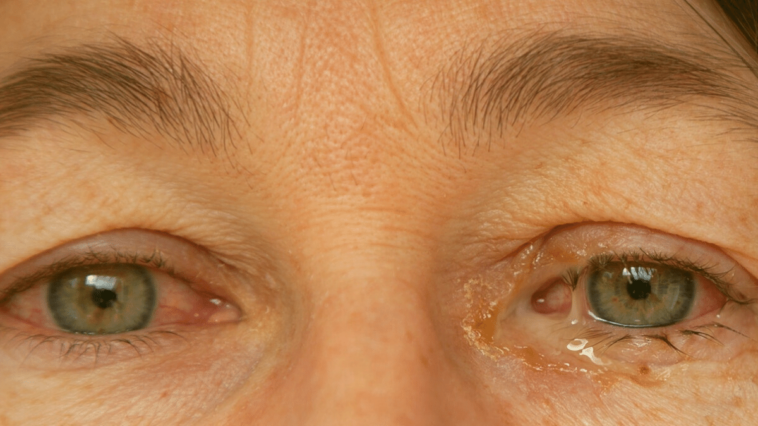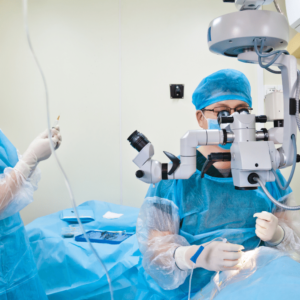What Is Eye Discharge?
Eye discharge, also known as eye mucus, combines various substances, including oils, mucus, and skin cells, produced by the glands in and around the eye. It can be clear, yellow, white, green, thin, watery, or sticky.
Normal, healthy eyes produce a small amount of clear or white discharge that helps to keep the eyes moist and lubricated. This type of discharge is usually not noticeable and does not cause any symptoms. There are several different types of eye discharge, and the appearance and consistency can vary depending on the underlying cause.
However, if the eyes produce an excessive amount of discharge or if the discharge is yellow, green, or has a foul odor, it can be a sign of an underlying condition such as an infection, allergic reaction, or a blockage in the tear ducts. In some cases, eye discharge can also accompany other symptoms, such as redness, itching, or eye pain.
If you are experiencing eye discharge and are concerned about it, you must speak with an ophthalmologist for a proper diagnosis and treatment.
What Causes Eye Discharge?
There are different causes of eye discharge, including:
Infections: Eye discharge is sometimes a sign of an eye infection or conjunctivitis (pink eye). This type of infection typically occurs when a virus or bacteria enters the eye and can quickly spread between individuals.
Allergies: Eye discharge is a symptom of eye allergies such as hay fever, which causes the eyes to produce increased tears.
Dry eye: Eye discharge refers to the fluids that come out of the eyes, which can be a symptom of dry eye syndrome. In this condition, the eyes produce a thin, watery fluid to lubricate and hydrate them.
Blocked tear ducts: Eye discharge can be caused by the obstruction of tear ducts. Tears can accumulate and spill over when blocked because they cannot drain away correctly. This leads to a discharge of watery liquid from the eyes.
Other conditions: Other conditions that can cause eye discharge include allergies, infections, eye trauma, or underlying medical conditions such as blepharitis (inflammation of the eyelids), uveitis (inflammation of the middle layer of the eye), and glaucoma (increased pressure inside the eye).
If you are experiencing eye discharge and are unsure what is causing it, it is crucial to see an eye doctor for proper diagnosis and treatment.
Symptoms of Different Types of Eye Discharge
There are several different types of eye discharge, and each can have symptoms. Here are some common types of eye discharge and their associated symptoms:
Watery discharge: Watery eye discharge is a common symptom of dry eye syndrome, allergies, or irritation and inflammation of the eyes. It may also be a normal response to everyday activities such as exposure to dust or wind. Additionally, some medical conditions can cause watery discharge from the eyes.
Yellow or green discharge: If you experience yellow or green discharge from your eyes, you could suffer from an eye infection such as pink eye. Other symptoms are redness, irritation, and swelling of the area around the eye.
Thick, sticky discharge: sticky eye discharge is not normal and can be a sign of an underlying problem, such as a blocked tear duct or an infection. Other symptoms may accompany it, such as redness, swelling, and eye pain.
Blood-tinged discharge: Blood-tinged discharge is a condition marked by the appearance of pink or red fluid from the eyes. While this may be due to a minor injury, it can also indicate something more serious, such as uveitis or glaucoma. If you experience this type of discharge, you must see an eye doctor for proper diagnosis and treatment.
Clear discharge: If you experience clear discharge accompanied by other symptoms such as redness, itching, or vision changes, it may indicate a more serious eye condition. If the discharge is tinged with blood, it may indicate injury or a more severe condition such as uveitis or glaucoma and should not be ignored. Always seek medical advice if you have any of these signs, as they may require urgent treatment.
Treatments for Eye Discharge
Eye discharge, also known as conjunctival discharge, can be caused by various underlying conditions and may require different treatment approaches. Here are some general treatment options for eye discharge:
- Cleaning the eyes: Remaining the eye with a warm, wet washcloth may help if the discharge is due to excess tears or debris. Avoid using soaps or other chemicals on the eye, as they irritate sensitive tissues.
- Using artificial tears: Artificial tears can help lubricate the eyes and reduce dryness and discomfort. These are available over the counter and can be used as needed.
- Using antibiotic drops or ointments: If the eye discharge is due to an infection, your doctor may prescribe antibiotic drops or ointments to help clear the infection and reduce the discharge.
- Using anti-allergy medications: If the eye discharge is due to allergies, your doctor may recommend antihistamines or other allergy medications to help reduce the discharge and relieve symptoms.
- Using warm compresses: Applying warm compresses to the eyes can help loosen and remove a dried discharge and soothe the eye.
- Treating the underlying cause: Depending on the cause of the eye discharge, your doctor may recommend other treatments, such as medication or surgery, to address the underlying condition.
It’s essential to consult a healthcare provider if you have persistent or severe eye discharge, as it can be a sign of a serious underlying condition.
Home Remedies for Eye Discharge
Some beneficial home remedies that may help reduce eye discharge:
Cleaning the eyes: To naturally reduce eye discharge, try cleaning the eyes with a warm, wet washcloth. Take care not to use soap or other chemicals near the eyes, as these can further irritate the tissues.
Using artificial tears: To help relieve eye discharge symptoms, people can use artificial tears, available over the counter. Artificial tears work by lubricating the eyes and helping to reduce dryness and discomfort. It is essential to see an eye doctor if eye discharge does not go away after using artificial tears.
Using warm compresses: To address eye discharge, a common home remedy is the application of warm compresses. These warm cloths or towels help loosen dried material and can be used to gently wipe away any excess. This can also soothe the area surrounding the eyes for added comfort.
Using a humidifier: One way to help is to use a humidifier in your home. Dry air can cause eye irritation and worsen eye discharge symptoms. Humidifiers add moisture to the air, which can reduce dryness and help keep your eyes feeling comfortable.
Reducing screen time: Excessive screen time can cause eye strain and dryness, leading to irritation and a feeling of something in the eyes that needs to be wiped away. It’s essential to take regular breaks from screens and frequently blink to keep your eyes lubricated.
Getting enough sleep: Proper rest is key to eye health and can help reduce the occurrence of eye dryness and discharge. To ensure your eyes stay healthy, get enough restful sleep every night.
It’s important to note that these home remedies may provide temporary relief but may not address the underlying cause of the eye discharge. If you have persistent or severe eye discharge, you must consult an ophthalmologist for proper diagnosis and treatment.
When to See an Eye Doctor?
Eye discharge can be a sign of an underlying condition that needs treatment. You must see an eye doctor for evaluation if you have persistent or recurrent eye discharge that doesn’t go away with home remedies. Here are some other indications that it may be time to see an eye doctor for eye discharge:
- Changes in the color or consistency of the discharge: If you notice changes in the color or consistency of your eye discharge, such as a sudden increase in the amount or thickness of the discharge, it’s essential to see an eye doctor for evaluation.
- Associated symptoms: If you have other symptoms besides eye discharge, such as eye pain, redness, vision changes, or sensitivity to light, it’s essential to see an eye doctor for evaluation. These symptoms can be indicative of an underlying condition that needs treatment.
- Recurrent infections: If you have recurrent eye infections accompanied by eye discharge, you must see an eye doctor for evaluation and treatment.
- Allergic reactions: If you have a history of allergies and your eye discharge is accompanied by other allergy symptoms such as sneezing, itchy eyes, or nasal congestion, it’s essential to see an eye doctor for evaluation and treatment.
It’s also a good idea to see an eye doctor if you have any concerns or questions about your eye health. Your eye doctor can evaluate you thoroughly and recommend the appropriate treatment plan.






